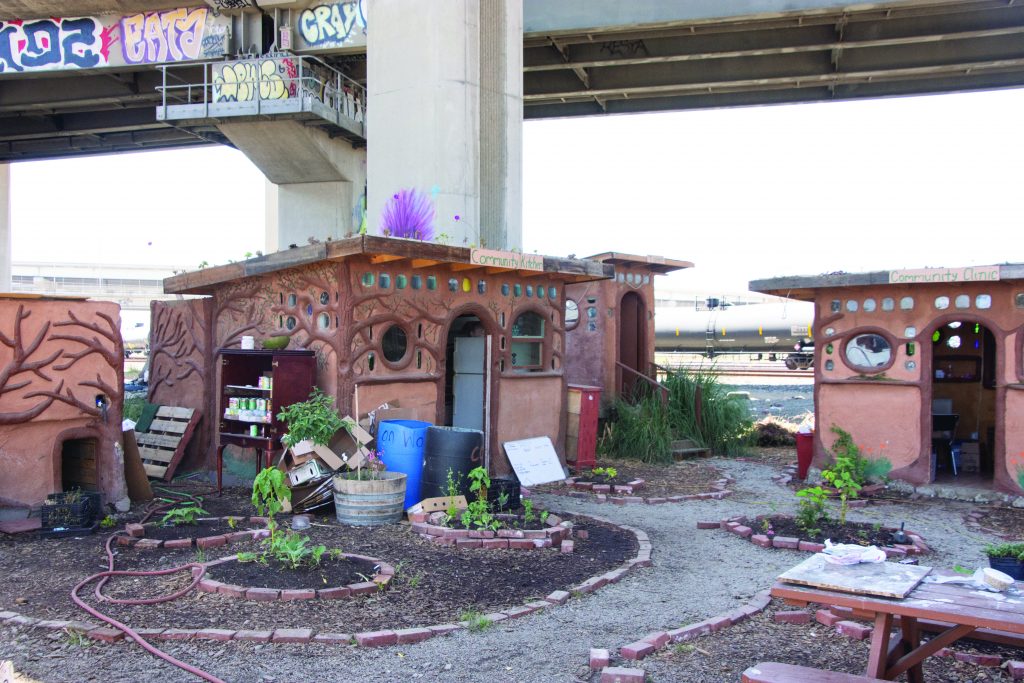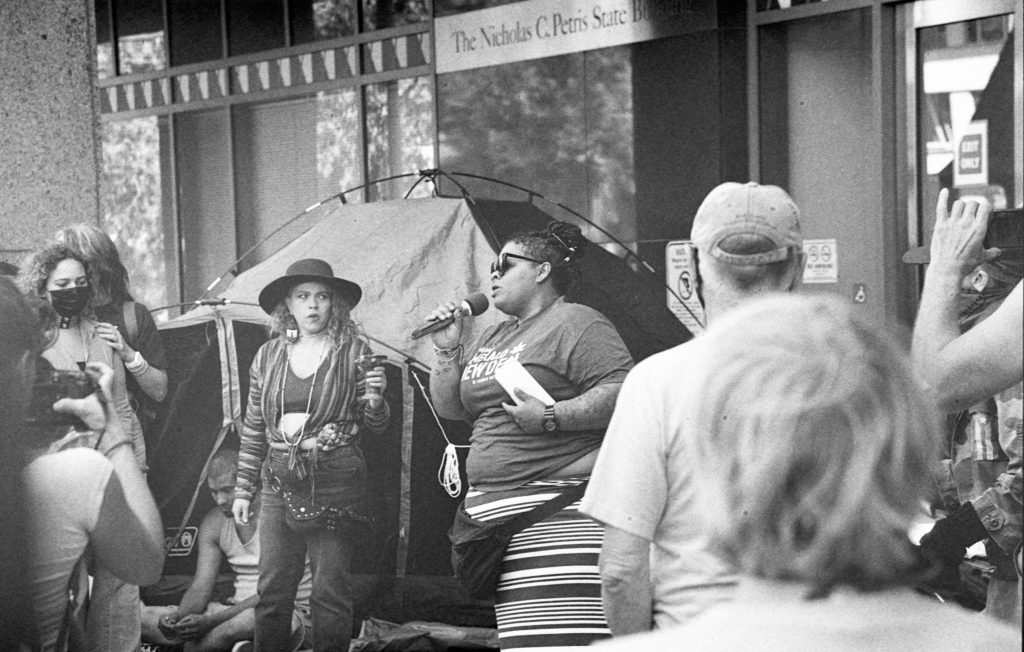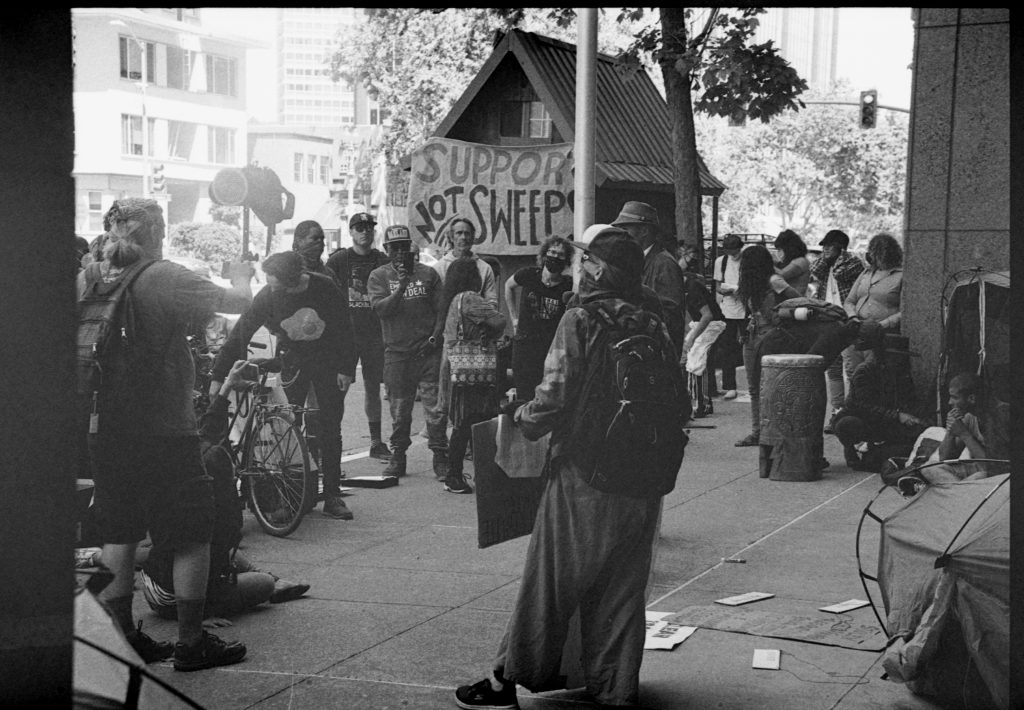
As the traffic on I-880 roars by overhead and a train slowly rumbles by in the adjacent railyard, more than a dozen unhoused people and activists enjoy fresh-baked pizza and listen to live music on an adjacent stage on a recent Sunday evening. Advocates from a variety of organizations, residents of the Wood Street encampment, and others paint protest signs as the smell of grilling burgers wafts through the air. “It’s a secret; we’re going to occupy Caltrans on Tuesday,” one of the residents whispers to me. I’m told the open mic and barbecue happens every Sunday evening, but this week they’ve added work on protest signs to prepare for the impending Caltrans sweep of the encampment, which will eventually include their community: a gathering of seven tiny homes and other resources that was built by residents and advocacy groups during the coronavirus pandemic. Residents worry that they will be displaced in the wave of encampment sweeps that has picked up again as the coronavirus pandemic subsides, and state and local authorities return to the regular practice of evicting residents from their curbside homes.
Cob on Wood, a little oasis in the midst of one of Oakland’s biggest homeless encampments, is a collection of small, unusual structures, vaguely reminiscent of something you might find in Grimm’s fairy tales. The tiny homes are striking against the otherwise concrete landscape, and are part of a community that offers services to the several hundred unhoused people who have found refuge west of Wood Street. Its vegetable gardens and decorative succulents offer a peaceful respite from the surrounding overturned cars and piles of debris—much of which is illegal dumping that people from the local community often leave on Wood Street. The community center’s hot shower and toilet offer more practical benefits. There’s also a working kitchen, a pizza oven, a small clinic with first aid supplies, and a free “store” for nearby residents containing clothing and hygiene products, toys, water bottles, and other practical items.
“It’s great,” said Shawn, a recent arrival to the Wood Street encampment. He most appreciates the toilet, which offers privacy when many residents previously had to find a spot near one of the freeway pillars to relieve themselves. It’s also safer, he added. “None of us asked to be in this situation,” he explained. “Cob on Wood has been nothing but positivity.”
Moose, who lives in a corrugated metal shed along Wood Street to the south, admits he was skeptical when construction at Cob on Wood began. But he said he has since come around, and agrees that the project supports the interests of Wood Street residents.
“It’s amazing,” says James, an Army vet who abandoned his former life and business when his wife was killed by a drunk driver, referring to the community center. “A shower with hot and cold water, a power source…” As we speak, he proudly starts up his meticulously maintained Harley-Davidson so I can hear the engine. James came to Wood Street when an Oakland church asked him to move his small RV because the neighbors were complaining.
The seeds of Cob on Wood, residents say, were sown half a year ago. One longtime resident said it started when “outsiders”—homeless advocates—began coming to the encampment offering healthy food and smoothies. Two Oakland-based advocacy groups, Essential Food and Medicine and Artists Building Communities polled local residents on their needs. They then funded construction of the various small buildings, overseen by Miguel “Migz” Elliott of Living Earth Structures. Wooden shipping pallets became walls and floors, the empty spaces between the boards stuffed with discarded clothing and debris to act as insulation. Everything was covered over with “cob”–a mix of mud, straw, and other organic matter–that has been used in construction since prehistoric times. With some paint, the buildings resemble little gingerbread houses.

Theo takes a break from singing and playing the ukulele to explain that the encampment is swirling with rumors that Caltrans, who owns land, plans to clear the encampment in the coming days or weeks. He doesn’t think there are any plans to find alternative housing for the residents, and wonders aloud how people in Oakland residential areas will react when the hundreds of people who are displaced from Wood Street set up camp in their neighborhoods.
Meanwhile, the GoFundMe site continues to raise funds for the project–currently totaling over $75,000. “The budget is still in its finalization process, but will be fully transparent and available for public view soon,” explained Annmarie Bustamante, an advocate with Artists Building Communities, via text message. She noted that the total amount raised includes over $30,000 that has already been spent, and provided a detailed breakdown of how she thought the remainder would be allocated—on things like resident stipends, landscaping, a health clinic, emergency sleeper cabins, eviction defense, vehicle upkeep, and more.
Given Wood Street’s uncertain future, several dozen project organizers, Wood Street residents, and other housing and indigenous land advocates gathered outside Caltrans’s District 4 headquarters on Tuesday, June 22. Several tents were set up on the sidewalk and one of the cob houses was parked on the street on a trailer as part of the protest. Alternating speakers aired a variety of concerns and demands as security guards stoically watched from inside the building’s glass doors.
When asked about the demonstration, a spokesperson for Caltrans cited the increasing number of fires over the last year as a major factor in efforts to find other options for the unhoused people living under the freeway. “Caltrans is working with the City of Oakland and other stakeholders in hopes of providing better alternatives for those who are living at Wood Street. For example, Caltrans is working with the City to secure community input on a $1.2 million RV lot that would make it possible for up to 50 RVs to park safely at the City-owned lot on Wood Street. Amenities such as showers, trash pickup and safe access to electricity and cooking facilities would be provided,” Janis Mara, a spokesperson for Oakland-based Caltrans District 4, wrote in an email.
Cheryl Chambers, Caltrans’ Deputy District Director for External Affairs says that there are no current plans to move residents immediately surrounding the Cob on Wood project. Residents of the parcel just to the south, between 18th Street and West Grand, however, are scheduled for eviction as soon as the RV lot is completed. Several residents of that area told Street Spirit they expect that in early July.
Long-time residents of Wood Street say that for years, Oakland police have encouraged unhoused people to go to Wood Street; now, it seems, even Wood Street is off limits for those who live outside. “What gives Caltrans all the authority to kick people out into the streets when that’s what taxpayers don’t want to see, is more motorhomes and homeless people on the streets?” asked encampment resident Shawn at the June 22 rally. Like many of Oakland’s unhoused people, he’s tired of being pushed from one place to another, without any prospect of a permanent housing solution. “What gives Caltrans the right?”

Thomas Brouns is a documentary filmmaker and student at UC Berkeley’s Graduate School of Journalism. He has served four overseas tours as an American diplomat and is a retired U.S. Army officer.
